by Ellen Wolter with Renae Youngs
Minnesota Compass recently launched a new Arts and Culture section! The data help us understand and track the important role arts and culture play in strengthening our communities and making Minnesota a great place to live. We developed the section with lots of help: funding from the McKnight Foundation, leadership from McKnight Program Officer Arleta Little, and input from a diverse set of artists and experts from around the state.
Minnesota Compass Researcher Ellen Wolter and (former) Minnesota State Arts Board Director of Research and Evaluation Renae Youngs identified the following four arts and culture facts in Minnesota that may surprise you.
1. A greater proportion of Twin Cities area residents attended live arts and culture events than Chicago and New York City area residents.
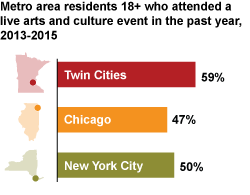
Ellen: New York and Chicago are the arts and culture capitals of the U.S., right? Maybe not. Fifty-nine percent of Twin Cities metro area residents reported attending a live arts and culture event in the past year compared with 47 percent of Chicagoans and 50 percent of New Yorkers. Among states, Utah ranks the highest with 61 percent of residents attending arts and culture events followed by Colorado, Montana, Wyoming, and then Minnesota with 55 percent. Residents in southern states, including Alabama, Missouri, Arkansas, and West Virginia, reported the lowest attendance of arts and culture events.
Renae: This data may suggest that people in our state place a high value on the arts: attending an event requires someone to invest their time (if not their money). Or it may suggest that Minnesota’s artists and cultural organizations are presenting arts offerings that attract more audience interest than their peers in other cities or states. These two views reinforce each other, since the artists and groups who offer relevant and interesting arts experiences are rewarded by the attention and investment of their audiences. It’s a positive cycle, and this indicator is one sign of its success in Minnesota.
2. Minnesotans are creating and performing art all across the state.
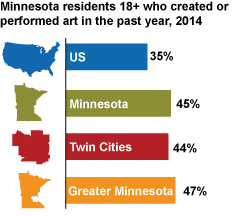
Ellen: Nearly as many Minnesotans report creating and performing art as they report attending arts and culture events. Minnesotans create and perform art at similar rates whether in greater Minnesota or the Twin Cities area. The top activities created and performed across the state include craft arts such as weaving, crocheting, quilting, and sewing; singing; photography; and playing a musical instrument.
Renae: One reason why arts participation matters is the potential for art to be transformative. The arts can introduce us to new ideas, perspectives, and people – and they give us ways to share something about ourselves with others. Research has shown that benefits can and do occur both when people attend arts events and when we express ourselves creatively. People who create or perform art may develop problem-solving skills needed to complete a tricky project, learn perseverance mastering a new artistic technique, boost their self-confidence, and even become better communicators along the way.
The best thing about these benefits gained by creative self-expression is that they are very democratizing: most anyone can write down a story, sing in the shower, or photograph a landscape. That means Minnesotans can experience and benefit from the arts no matter where they live. Someone who’s just down the street from a community theater, in an apartment above a big-city art gallery, or practicing at grandma’s piano on a century farm all stand to gain from their participation in the arts.
3. Younger Minnesotans are more likely to attend live arts and culture events, but less likely to create and perform art, than older Minnesotans.
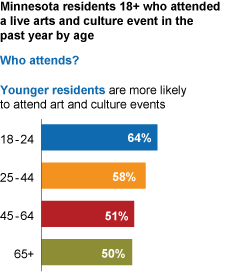
Ellen: Sixty-four percent of Minnesotans age 18-24 attended live arts and culture events compared with 50 percent of adults 65 and older. In contrast, 40 percent of residents 18-24 created or performed art compared with 58 percent of adults 65 and older. Common barriers to attendance among older adults include accessibility of the venue as well as social isolation, with some older residents not attending arts events because they could not find someone to go with them.
Younger adults who participate are more likely to report being engaged in visual art, such as photography and graphic design, making films, and playing a musical instrument. Older adults who create and perform art are more likely to participate in craft arts and performing and practicing singing.
Renae: These data are encouraging because they show that adults of all ages are participating in the arts, whether as attendees or as creators and performers. They also raise very interesting questions for decision-makers. Those who aim to set public policy related to the arts might want to know if the ways one group participates in the arts are related to particular benefits they want to see for that group, such as improved health outcomes or quality of life for older adults. Those who offer arts programming also have an interest in data that suggest what kinds of arts experiences might be a bigger draw among different groups, and why – or what strategies might help engage a group in a particular art form or type of experience.
4. Minnesota families report high engagement of their children in arts classes at school, but much lower engagement in arts classes and activities outside of school.
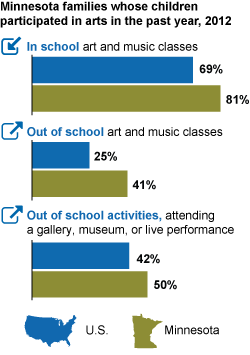
Ellen: In 2012, 81 percent of Minnesota’s families reported that their school-aged children received an arts and music class in school, which is well above the national rate of 69 percent. Fewer families reported their children attending out-of-school arts activities; 41 percent of children have taken an art or music class after school or have attended a live arts event in the past year.
Renae: This is a particularly interesting set of indicators for the Minnesota State Arts Board. While the Arts Board awards grants to support arts learning for both children and adults, it primarily supports arts learning outside of schools and does not have a formal statewide role in K-12 arts education. To the Arts Board or others who want to increase arts participation for Minnesota children, both out-of-school arts classes and attendance at arts events may be good investments. Although these data provide a key starting point for understanding arts education in Minnesota, there is more work to do to dig deeper into how to best support and enhance youth arts participation. The needs and interests of different communities, the resources needed for staffing or curriculum development or student transportation, and lots of other factors all shape how investments in students’ arts participation are made.
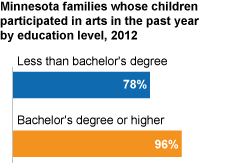 Ellen: We know from research that children who are exposed to artistic events or who have taken an art class are more likely to attend arts events and be engaged in the arts as adults, and some research has shown that youth arts participation may be a better predictor of adult arts participation than race or socioeconomic status. So which children in Minnesota are most likely to participate? The data are not yet precise enough to show whether children in different regions of Minnesota are more or less likely to participate, or whether children from higher income families are more likely to participate than those from lower income families. But the data for Minnesota do suggest that children of more highly-educated parents participate in the arts at higher rates. Increasing early exposure to arts events for all children may alter this pattern later in life.
Ellen: We know from research that children who are exposed to artistic events or who have taken an art class are more likely to attend arts events and be engaged in the arts as adults, and some research has shown that youth arts participation may be a better predictor of adult arts participation than race or socioeconomic status. So which children in Minnesota are most likely to participate? The data are not yet precise enough to show whether children in different regions of Minnesota are more or less likely to participate, or whether children from higher income families are more likely to participate than those from lower income families. But the data for Minnesota do suggest that children of more highly-educated parents participate in the arts at higher rates. Increasing early exposure to arts events for all children may alter this pattern later in life.
Renae: That’s a great example of one small piece of data that could really shape how someone decides to invest in the arts in order to create a certain result: supporting youth arts engagement in order to encourage more lifelong participation.
Conclusion
Arts and culture data have been emerging and evolving in recent years, and the new Arts and Culture section on Minnesota Compass, along with other great work being done by the McKnight Foundation, the Minnesota State Arts Board, Creative MN, and the city of Minneapolis, enhances our collective understanding of Minnesota’s local arts and culture landscape. Arts and culture data advance the conversation about how Minnesotans participate in the arts, help us understand the economic impact of the arts, and help us consider ways we can sustain and strengthen arts and culture here in Minnesota.
And yet, there is still work to be done to develop and enhance available arts and culture data; there are many arts-related benefits and indicators that could be tracked but limited data make this difficult. For example, a hundred artists or arts organizations might be trying to accomplish a hundred different things through their artistic work, and there is no single listing of who they serve or how successful they are. Fortunately, there are more efforts seemingly every day to create or make sense of arts-related data. Researchers, artists, grant makers, arts advocates, and a host of others are striving to paint a clearer picture of the benefits and value of the arts. This is a national and global effort, and Minnesota is taking the lead thanks to efforts of groups like Compass, the McKnight Foundation, Creative Minnesota, and the Arts Board.
Minnesota Compass is excited to partner with the Minnesota State Arts Board, McKnight Foundation, and our many advisors to contribute to the developing conversation among local and national arts organizations to advance arts and culture data and research here in Minnesota.
So, dig in to the Minnesota Compass Arts and Culture section to learn more about how we participate in arts and culture here in Minnesota. Let us know what you’ve learned, what questions were raised for you, and how we can continue to develop and enhance arts data in Minnesota. Feel free to get in touch with us at ellen.wolter@wilder.org to share your ideas.
Check out a few of the new Arts and Culture resources in the Compass library: